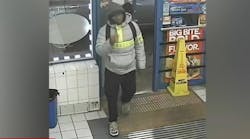Studying domestic violence for more than 25 years, Jacquelyn Campbell, Ph.D., of the John Hopkins University School of Nursing, found that in 50 percent of domestic violence-related homicides, officers had previously responded to a call where a homicide occurred.
Rarely do victims who may be killed or seriously injured seek help to end the cycle of violence. Campbell's research shows only 4 percent of domestic violence murder victims nationwide had availed themselves to domestic violence intervention services. Yet these services are important. Campbell found that the re-assault of domestic violence victims in high danger was reduced by 60 percent when they went to a shelter.
Handing out print materials that describe domestic violence intervention resources and contact information didn't seem to prompt any action — other than frustrating the officers because victims weren't seeking help.
"There are some domestic situations that just trouble you — you worry something is going to happen to the victim, and there wasn't anything you felt you could do about it," says David Sargent, a retired police officer who's now a consultant and trainer for the Maryland Network Against Domestic Violence (MNADV).
In Maryland and seven other areas of the country, that's changing. Based on Campbell's research, MNADV put together a model program to prevent domestic violence homicides and serious injury by encouraging more victims to seek services offered by domestic violence intervention programs. MNADV's Lethality Assessment Program (LAP) has two parts: the lethality screen for first responders to identify victims with increased risk for homicide; and a protocol to refer victims to services, such as counseling and shelter. All Maryland law enforcement agencies that respond to calls for service use LAP; and in 2009, additional agencies in Florida and Vermont implemented LAP.
Better understanding
Before officers started using the lethality screen, Officer Erika Heavner of the Howard County Police Department in Maryland describes she and other officers primarily focused on "the here and now."
In other words, they were identifying if anyone is injured, or how to resolve the situation at hand.
She says when questioned, a victim might have said little more than, "We argued, he shoved me and left."
The lethality screen helps officers delve deeper to better understand a situation and recognize the danger signs predictive of homicide, or as the LAP information packet says, officers learn to read the danger signs.
Not every victim of domestic violence is screened. Officers initiate a lethality screen when an intimate relationship is involved and:
- An assault is believed to have occurred;
- The potential for danger is high;
- Officers responded to calls involving the victim or location before;
- Or an officer believes an assessment should be conducted.
If a victim resists screening, he or she becomes a lost opportunity.
"We don't know if she's a high-danger victim or not," Sargent says.
If a victim agrees to participate in the screening, 11 yes-or-no questions are asked based on Campbell's work looking at why more than 4,000 victims of domestic violence were killed or nearly killed, and are modeled after Campbell's dangerous assessment instrument for clinical use.
Using a checklist format, officers can consistently obtain the most valuable information.
Questions, for example, include:
- Has he or she ever used a weapon against you or threatened you with a weapon?
- Do you think he or she might try to kill you?
Retired Howard County Sgt. Steve Martin, who supervised his department's domestic violence unit, says when officers initially started using the screening tool, they would say, "I can't believe how bad this woman has it."
Overall, Martin found officers trained to use the screening tool became more empathetic to a victim's plight.
Following protocol
After a victim has been identified as a high-danger victim, officers use the LAP protocol. They tell victims that they are in danger. Specifically, an officer may say, "In situations like this, people have been killed."
Next, the officer says, "What I'd like to do now is call the domestic violence hotline so I can get some information to help you. While I'm on the phone, I'd like you to think about speaking with the hotline worker."
Regardless of whether or not the victim says he or she wants to talk to a hotline worker, the officer will call the hotline and provide basic information. If the victim has previously indicated he or she does not want to talk on the phone, the officer again encourages him or her and asks if the victim would like to talk to the hotline worker. If the victims still does not want to talk on the phone, they don't have to. The advocate then provides basic safety planning information that the officer conveys to the victim.
If the victim has said yes, the officer hands the victim the phone. The hotline worker's objective in a brief conversation (no more than 10 minutes) is to encourage the victim to go into domestic violence intervention services. Hotline workers have written guidelines to help ensure a victim gets basic information for immediate safety planning, and can even schedule the victim to see a counselor.
"While we want to be proactive, we want to give the victim information that will empower her to decide to seek help," Sargent says. "It's always the victim who is making the decision. The emphasis in training is on encouraging the victim. The police officer encourages the victim to talk on the phone, and the advocate encourages the victim to go in for services."
Most advocates and officers in Maryland then provide further encouragement and support through follow-up home visits or phone calls.
Realizing the danger
Research has shown that victims who experience domestic violence early on continue to be victims of abuse through life, thinking that's the norm, Martin points out. They don't think they need help, he adds.
By going through the questions, victims start to realize the danger they are in.
"I think it helps them see — for their sake and for the sake of their kids — they really need to start taking steps to get out of the situation," Heavner says.
Before lethality assessments, Heavner says a victim tended to downplay her situation. She would say something like, "This is just how he is, this kind of stuff has always happened. I just can't get rid of him." The victim wouldn't necessarily come forward with the fact that she was threatened in the past.
Heavner remembers a woman's ex-boyfriend kicking down the woman's door to break into her home when she and her two young daughters were present. He left before police officers arrived on the scene, and they had been to the scene before. Once the victim answered the assessment questions and heard herself verbalize what was really going on, she started thinking about getting a protective order and going forth with charges.
In general, Heavner says victims are more willing to take action because they've been confronted with serious information.
10 minutes could save a life
Agencies looking to implement LAP may find, as Howard County did, the biggest challenge is that all patrol officers will need to be trained.
Another challenge Martin says is officer buy-in. Officers will need to fill out another form. LAP does not replace pre-existing forms, but in some cases agencies have combined the written LAP assessment with another form.
A common question officers ask Ron Russum, the LAP contact person and trainer for the Mid-Shore Council on Family Violence in Maryland, is how much time LAP takes. On average, he says it takes 5 minutes to do the screening and another 5 if the victim wants to speak to a domestic violence advocate.
Sargent says, "Our goal was to make a tool that was going to be as user-friendly as possible for police officers. Part of making the assessment tool user-friendly was ensuring that the assessment and protocol would be brief."
When officers realize how easy it is for them to take another step to assist victims, Russum says they are impressed.
Assessing the assessment
Moreover, Sargent says 50 percent of the officers surveyed during the field test in 2004 said having the protocol boosted their confidence in being able to deal with a dangerous domestic situation.
Officers also commented in the survey that they now view the local domestic violence program as they view social services in child abuse cases — they're part of the team.
"I don't know that we've been using LAP long enough to really gauge it," Russum says. "But from what I can see, it's definitely working. Programs offering services to domestic violence victims are reaching people that they never would have reached if it hadn't been for LAP."
LAP benefits not only the victims of domestic violence and their families, it also benefits law enforcement. Having read the domestic-related reports and incidents for his department, Martin says there have been fewer calls to certain residences, "because we're getting more victims into services."
Russum, a retired state trooper, police chief and deputy sheriff, says, "I would encourage every police agency and domestic violence intervention program in the nation to explore how they can make LAP work in their area and implement it when they can. Police can't work without the domestic violence programs, and the programs can't work without the police. They have to work together."
Victims' attitudes are changing, he says. They may have heard that help is available before, but he says it's never been this easy to get help.
LAP is an award-winning program. The Ash Institute for Democratic Governance and Innovation at Harvard Kennedy School named LAP as one of the Top 50 Programs of the 2008 Innovations in American Government Awards competition.
Law enforcement agencies participating in LAP track how many high-danger victims talk to a domestic violence advocate. Maryland's four-year average, from 2006 to 2009, was 59 percent (7,090). Another statistic agencies track is how many victims went into services (for counseling or shelter, for example). Here, the statewide average for the same time span is 30 percent (2,072), which may not seem like a lot, but Sargent reminds that Campbell's research showed only 4 percent of victims at risk of being killed ever sought the help of a domestic service provider. Going beyond the four-year average, Sargent sees this percent increasing. Last quarter, 37 percent (296 victims) sought help, he says.
"I credit the police officers and the domestic violence advocates on the hotline for doing a better job of getting these victims who are not necessarily ready to get on the phone to go into those services," he says.
Community response
Police officers and hotline workers were the first to receive LAP training. MNADV's overall goal is to promote a coordinated community response using LAP.
"We want anyone who might come into contact with a victim to know the signs of lethal danger and be able to do virtually the same thing a police officer does — use the screen, say the same kinds of things to the victim and connect the victim to the local domestic violence intervention provider," Sargent says.
Already he has been working with two hospitals to create a model for health care workers.
Others MNADV looks to include are clergy, legal advocates, social workers, educators, businesses, community groups, family members and the general public.
"Family members may know what's going on but maybe don't know what to do or where to turn," Sargent says. "We want them to know there's a place victims should be encouraged to call. We don't want to create undue alarm, but we want them to understand that they may have a loved one who is in grave danger."
Sargent's team has begun working with two counties in Maryland, so various agencies and organizations throughout the county are doing the LAP through a coordinated community response approach.
Once you start doing LAP, he says, the positive effects start rippling out and educate the entire system.
End the cycle
MNADV is working to extend the training beyond Maryland's borders. In October 2008, the Department of Justice awarded an Edward Byrne Memorial Grant to MNADV to provide train-the-trainer instruction and technical assistance to law enforcement and community-based domestic violence programs.
Kansas City (Mo.) Police Department is in one of those areas. Police officers responding to calls, taking reports, investigating and making arrests — these things don't break the cycle of violence, says Capt. Mark Folsom, commander of the Kansas City Police Department Special Victims Unit. Law enforcement is just part of the equation, he says. "By involving domestic violence advocates, hopefully we get victims help so the cycle can be broken.
"Our goal is to make a difference in the community by connecting victims to the resources that they need," Folsom says. "Hopefully, that makes a difference for them personally. Hopefully, that makes a difference for us, as a police department, by lowering our crime numbers. And hopefully, that makes the city a safer place to live in."
From June to December 2009, Kansas City did 1216 attempted screens. Of those, 831 were high danger, and 514 of the high-danger victims spoke to a counselor.
"[LAP is] something that at the very minimum tells the victim she's in a dangerous situation," Folsom says. "Maybe that's all it takes for her to change her life and get the help she needs."
Editor's note: For further information on LAP, see www.mnadv.org.
Rebecca Kanable is a freelance writer specializing in law enforcement topics. She can be reached at [email protected].


